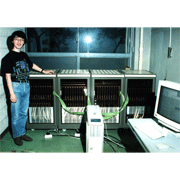The name GRAPE was taken from "gravity pipe". Systems, like galaxies, in which multiple particles (O(N)) exert gravitational pulls on each other, require massive calculations on the order of O(N2) to find the universal gravitation. The project to build a computer dedicated to solving this type of gravitational calculation began in April 1989, and the GRAPE-1 machine was completed in September of that year. A host computer sent the positions of fixed stars to GRAPE, which performed the gravitational calculations and returned the combined force on each star to the host computer. The host computer used the returned information to update the position of the stars. GRAPE-1 and GRAPE-2, which was completed in April 1990, were single-board systems using around 100 commercial LSI chips, but for GRAPE-3, which was completed in 1991, a single custom LSI chip was developed that integrated all the circuitry equivalent to the GRAPE-1’s board. GRAPE-3 reached speeds of 14.4 gigaFLOPS by running 48 of these custom LSI chips in parallel.
For GRAPE-4, the development of which began in 1992 and was completed in the summer of 1995, two LSI chips were developed: the Prometheus to calculate at high speeds individual time steps and the Harp to calculate the time-integration and gravity of particle accelerations. GRAPE-4 reached speeds of 1.08 teraFLOPS by connecting 36 processor boards, each with 48 Harp chips and one Prometheus chip, via four control boards to the host computer. The development of GRAPE-6 began in 1997 and was completed in 2001. GRAPE-6 reached 64 teraFLOPS with 2,048 chips. Aside from gravitational calculations, the MD-GRAPE system was developed, which was specialized for simulations of molecular dynamics.
Although the initial MD-GRAPE machine was developed at the University of Tokyo, RIKEN started developing MDGRAPE-2 in 1995, which attained speeds of 75 teraFLOPS when completed in 2002. Development of successors to GRAPE-6 and MDGRAPE-2 continues.
Compiled from pp.199-200, "The History of Japanese Computers", edited by the Special Committee for the History of Computing, IPSJ. Ohmsha, 2010.


